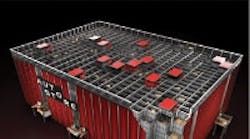Komplett ASA is a leading player in e-commerce, delivering PC components, PCs and other related electronic equipment to consumers and companies throughout Norway, Sweden and Denmark. Founded in 1996, the company has grown to host nine separate webshops, some of which rank as the first and second largest e-commerce sites in Scandinavia. Komplett aims to be the single link between manufacturers and its customers, which include end-users, businesses, public enterprises and resellers.
In 2010, this retailer posted sales of more than $700 million, while servicing 675,000 active online customers. From its 270,000 square-foot central distribution center in Sandefjord, Norway, the company fulfills all of its orders and ships to its customers throughout Scandinavia. In 2010, Komplett prepared and shipped 1.4 million orders, nearly 4.3 million items.
But these production volumes represent throughput after the company’s move to an automated distribution center. For more than a decade prior, Komplett fulfilled its orders manually. That meant floor trucks moving pallets into storage racks, and case-picking where workers would receive orders from the company’s ERP line-by-line, then pick using hand-held RF scanners with products being picked one-by-one. There is no pick-to-light or pick-to-voice, minimal conveyors and little sortation equipment. Basically it was traditional manual warehousing.
This system was workable for the company for a decade or so, but as Komplett continued to expand its market reach by acquiring and building new webshops and increasing its product offerings to more than 10,000 SKUs, the need for a more streamlined and automated solution reached a critical level.
“We needed to make a change to our DC operations for a number of reasons,” says Pal Asbjorn Vindegg, chief operating officer for Komplett. “More efficiency was one of the drivers. Our manual operation was just not able to keep up with the order volumes any longer. But we also needed more space for storage for our increasing number of products, especially for small products.”
The company looked at a number of options, knowing it needed more storage space, but that it couldn’t extend its warehouse. Management realized the company needed some kind of automation to handle its storage requirements and streamline its throughput.
Mini-loads were one option the company explored, but it found such a system would be difficult to fit into its existing DC because the building would need more height. Managers were also concerned that if one of the mini-load cranes were to stop, pickers would not able to reach the locations connected to that crane.
Optimizing storage, streamlining fulfillment
After considering a variety of solutions, the decision was made to select Swisslog’s AutoStore as the central system for the distribution center’s automated storage and fulfillment operation. The system is designed for operators requiring both dense storage and efficient piece- and small-case picking, which was what Komplett needed.
Element Logic AS, a local integrator in Norway, installed Komplett’s AutoStore system. Swisslog is the exclusive distributor of AutoStore in North America. It also distributes the system in much of Europe. AutoStore is a registered trademark of Jakob Hatteland Logistics AS, and manufactured by the company in Norway.
The system is made up of a three-dimensional grid of self-supporting bins that are moved to pick stations by independently-operating robots. Each robot has two sets of wheels that enable it to move along two axes. This makes it possible for all robots to reach any position on the grid. The robots are equipped with a lift for picking up, carrying and putting Komplett’s 33,000 bins that are stored in the grid. They communicate via wireless controls to the WMS and Komplett’s pick stations.
The system stores goods with minimum space requirements. With no room necessary for lift trucks, roads or ramps, it uses the available storage space to the maximum. Swisslog claims it stores up to 60 percent more goods per cubic foot than conventional warehouse systems.
Flexibility was another Komplett requirement, and the system can be adapted and expanded as needed. Komplett’s installation could easily be extended, if the need warrants in the future, without interfering with its throughput. Storage space can be added by simply extending the grid. Additionally, pick rates can be enhanced by adding more robots to the system. Currently, Komplett is running 55 robots, having already increased the number of robots twice since the system was installed.
“The system can easily be adapted to fit different building heights, span multiple levels and even surround obstacles in the warehouse, such as pillars or walls,” says Bill Leber, director of business development and marketing for Swisslog. “The various restrictions of Komplett’s existing building posed no difficulty for the new system.”
Several modules that operate independently of each other means there is no single point of failure. Should one of Komplett’s robots need maintenance, its tasks will automatically be taken over by other robots deployed in the system.
“If Komplett needs to increase capacity, it is very easy to extend the number of robots and increase the number of picking stations,” Leber continues. “It is also rather easy to extend the grid itself and add more bins, with no negative impact to ongoing operations.”
The system automatically optimizes the storage position of goods in the grid by keeping the more frequently requested products higher up for faster access times.
DC flow
Automated storage and retrieval (AS/RS) is just one module in a total system. Komplett also installed 1,200 linear feet of conveyor and a shipping sortation system to improve inbound and outbound material flow.
From receiving inbound, Komplett first registers that it has received the products. Then it puts the majority of its items (80%) into the automated storage system for the small items, and into racks for bigger items like flat screen TVs, PCs and laptops. It has about 5,000 pallet locations, a racking system for buffer storage, and 28 pick stations for both inbound and outbound.
When a robot delivers a bin to a pick station, a worker picks the required number of units and the robot returns the bin back to storage. The new bins are thereby delivered back-to-back and the operator rarely has to wait for bins.
Komplett’s AS/RS can hold approximately 700 live picking tasks in its queue at any one time. There is an operator interface panel on every pick station, showing pick status information. The total performance of the system can be controlled by a number of different parameters.
From the pick stations, the orders are packed in boxes, which are conveyed away from the picking stations, automatically labeled, and conveyed through a shipping sorter to the 15 shipping gates.
30% increase in efficiency
“We like the idea that the system will reconfigure the position of SKUs based on those used most,” explains Vindegg. “The system always picks from the top, so if we have to use one bin very often it will just stay on the top. And the bins that we very seldom need sink to the bottom. Our statistics show that 90 to 95% of what we pick most often is in the three upper layers. That gives us automatically more efficiency.”
Since Komplett completed the automation, its man-hours have been reduced and its volume of orders have increased. The company has switched people from pick-and-pack to receiving because the automation increased the workload in the receiving area.
“What we look at is the productivity for the total warehouse, and we show a 30% efficiency increase for the entire DC operation,” says Vindegg. “That is based on counting orders per spent man-hours. Man-hours have been reduced, compared to the number of orders which have increased. That is a very important key performance indicator for us.”
Jim McMahon writes on logistics automation. He can be reached at [email protected].



